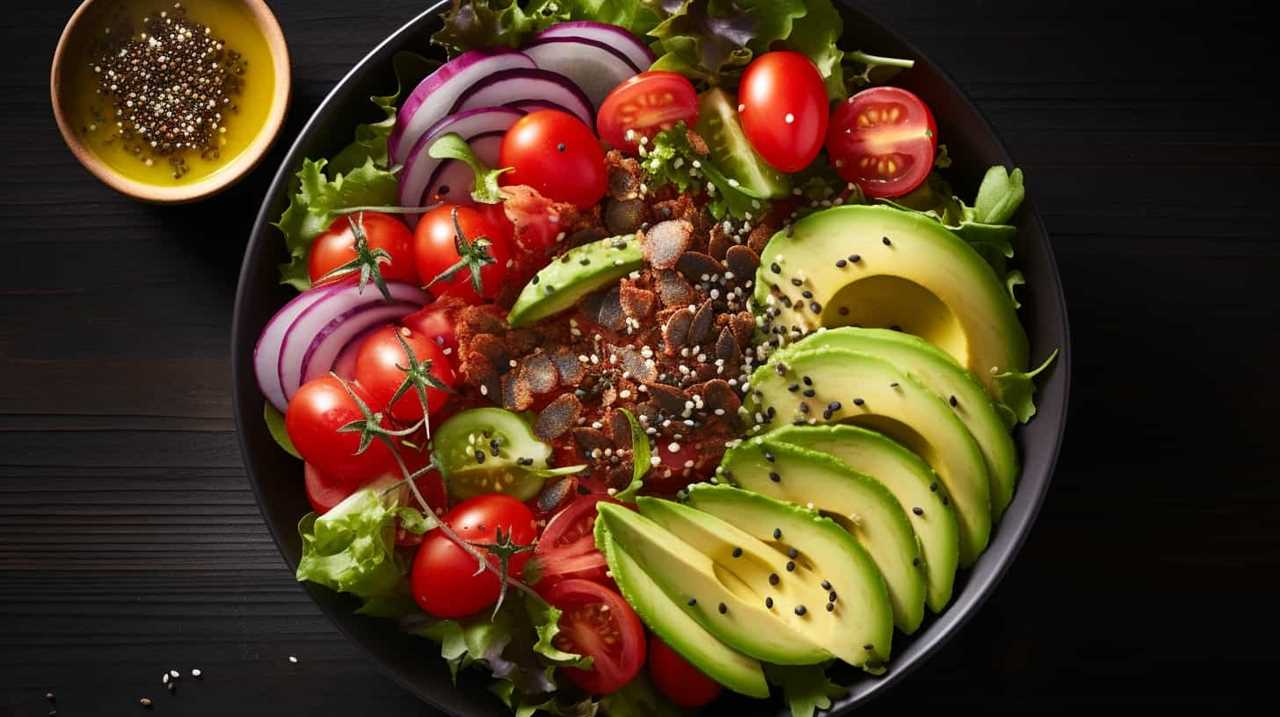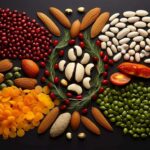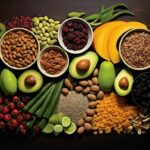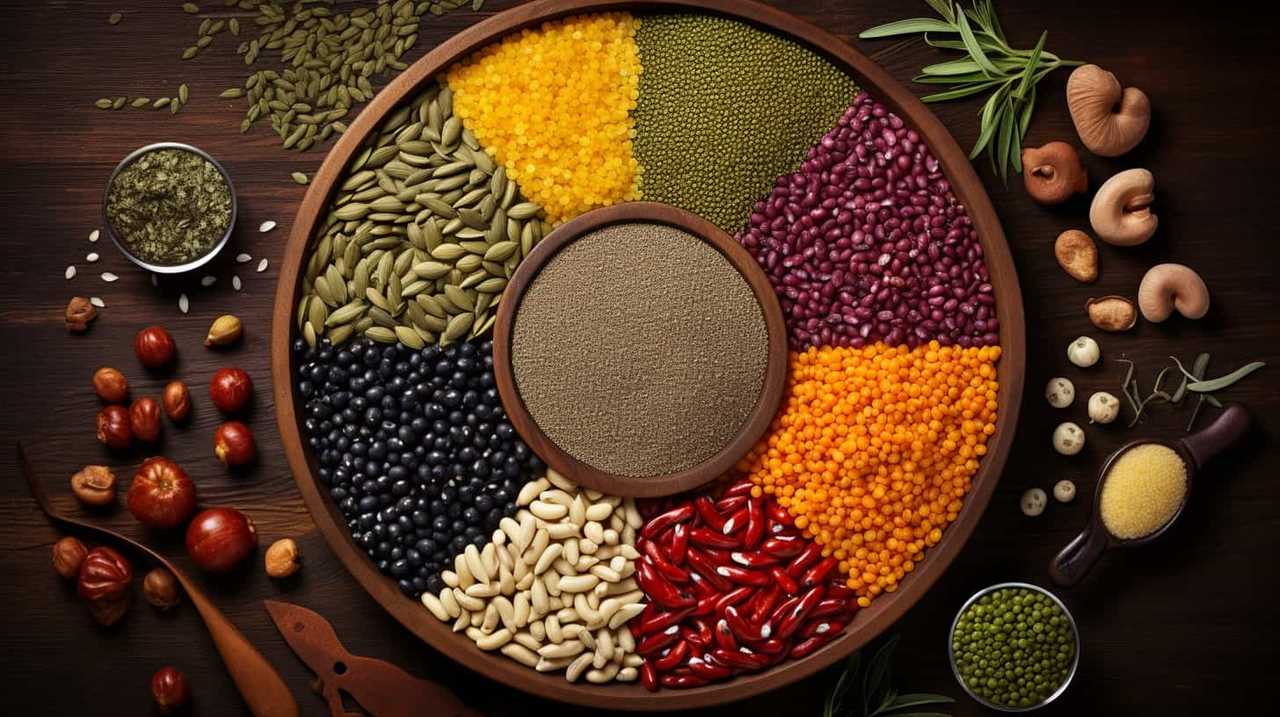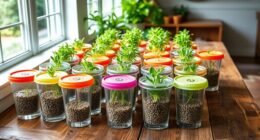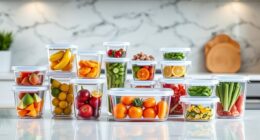We have discovered 9 fantastic gluten-free breakfast recipes packed with super seeds to jumpstart your morning!
From overnight oats infused with chia seeds to mouthwatering banana bread made with nutrient-rich chia seeds, these recipes are sure to satisfy your cravings while providing a nutritious start to your morning.
With the added benefits of super seeds, these breakfast options are a great way to fuel your body and keep you energized throughout the day.
Let’s dive in and explore these scrumptious and wholesome recipes together!
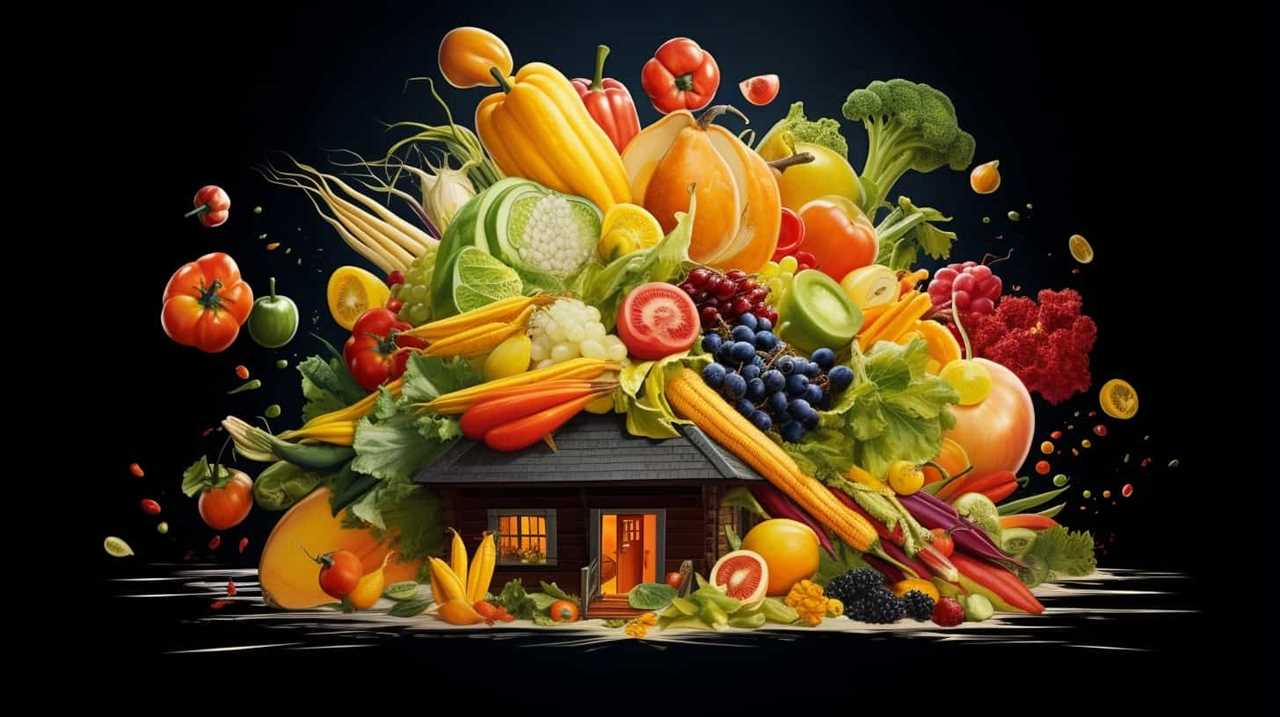
Key Takeaways
- Chia seeds are a nutritious addition to breakfast recipes, providing fiber, omega-3 fatty acids, antioxidants, and protein.
- Chia seeds promote satiety, aid in weight management, and regulate bowel movements.
- Flax seeds are a suitable alternative to chia seeds, offering similar health benefits such as fiber, omega-3 fatty acids, and improved digestive health.
- Chia seeds can be incorporated into various breakfast dishes, including overnight oats, yogurt parfait, smoothie bowls, and granola bars for added nutrition and texture.
Chia Seeds Overnight Oats
We love making Chia Seeds Overnight Oats for a delicious and nutritious gluten-free breakfast option. Chia seeds are packed with fiber, protein, and omega-3 fatty acids, making them an excellent addition to any meal.
To prepare Chia Seeds Overnight Oats, simply combine 1/4 cup of chia seeds with 1 cup of your favorite milk or dairy-free alternative, along with a sweetener of your choice. Mix well and let it sit in the refrigerator overnight. In the morning, you’ll wake up to a thick and creamy oatmeal-like consistency that can be enjoyed as is or topped with fresh fruits, nuts, or a drizzle of honey.
These overnight oats aren’t only easy to make but also versatile. You can experiment with different flavors by adding ingredients like cocoa powder, vanilla extract, or cinnamon. For a refreshing twist, try blending the soaked chia seeds with fruits and yogurt to create a chia seed breakfast smoothie.
If you’re craving a heartier option, incorporate chia seeds into your protein pancakes for an added nutritional boost. These gluten-free pancakes can be made by combining mashed bananas, eggs, protein powder, and chia seeds. Cook them on a non-stick pan until golden brown and serve with your favorite toppings.

Chia Seeds Overnight Oats, chia seed breakfast smoothie, and chia seed protein pancakes are all fantastic ways to start your day with a healthy and satisfying meal.
Chia Seed Pudding With Berries
To continue exploring the versatility of chia seeds in gluten-free breakfast recipes, let’s delve into the delightful world of Chia Seed Pudding With Berries. This creamy and nutritious pudding isn’t only delicious but also incredibly easy to make. Here are four reasons why you should consider adding this delightful dish to your breakfast rotation:
- Healthy and Filling: Chia seeds are packed with fiber and omega-3 fatty acids, making them a nutritious addition to any breakfast. Combined with the natural sweetness of berries, this pudding will keep you feeling satisfied and energized throughout the morning.
- Quick and Convenient: Chia seed pudding can be prepared the night before, making it a perfect grab-and-go option for busy mornings. Simply mix chia seeds with your choice of milk, sweetener, and vanilla extract, then let it sit in the fridge overnight. In the morning, top with fresh berries and enjoy!
- Versatile: Chia seed pudding is a blank canvas for creativity. Feel free to experiment with different flavors and toppings to suit your taste. You can even add chia seeds to your favorite smoothie recipes or use them in chia seed breakfast muffins for an extra boost of nutrition.
- Gluten-Free and Vegan: Chia seed pudding is naturally gluten-free and vegan, making it a fantastic option for those with dietary restrictions. It’s a great way to start your day on a healthy note while still enjoying a delicious and satisfying breakfast.
Incorporating Chia Seed Pudding With Berries into your breakfast routine is a simple and nutritious way to kickstart your day. Give it a try and experience the deliciousness and health benefits of chia seeds.
Chia Seed Smoothie Bowl
Making a Chia Seed Smoothie Bowl is a refreshing and nutritious way to start our day. Chia seeds are packed with fiber, protein, and omega-3 fatty acids, making them a great addition to any breakfast dish.

To make a chia seed smoothie bowl, simply blend together your favorite fruits, such as berries or bananas, with a liquid of your choice, such as almond milk or coconut water. Then, add a tablespoon or two of chia seeds to the mixture and blend until smooth.
Pour the smoothie into a bowl and let it sit for a few minutes to allow the chia seeds to thicken. Top with your favorite toppings, such as granola, coconut flakes, or sliced fruit, and enjoy a delicious and nutritious breakfast.
This chia seed smoothie bowl isn’t only a creative way to use chia seeds in breakfast dishes but also provides a satisfying and energizing start to your day.
Chia Seed Pancakes
Let’s talk about the health benefits of chia seeds and explore the option of using alternative seeds in our pancake recipes.

Chia seeds are packed with nutrients like omega-3 fatty acids and fiber, which can contribute to a healthy digestion and heart health.
However, if you’re looking to switch things up, consider using other super seeds like flaxseeds or hemp seeds. These seeds also offer a range of health benefits and can add a delicious twist to your pancake breakfast.
Chia’s Health Benefits
While chia seeds are commonly known for their health benefits, we can enhance the nutritional value of our breakfast by incorporating them into delicious gluten-free chia seed pancakes. Here are four reasons why chia seeds are a great addition to our morning meal:
- High in Fiber: Chia seeds are packed with fiber, which aids in digestion and helps keep us feeling full and satisfied throughout the day.
- Omega-3 Fatty Acids: These tiny seeds are one of the best plant-based sources of omega-3 fatty acids, which are essential for brain health and heart health.
- Antioxidants: Chia seeds contain antioxidants that help protect our cells from damage and reduce inflammation in the body.
- Protein Powerhouse: Despite their small size, chia seeds are surprisingly high in protein, making them a great option for vegetarians and vegans looking to increase their protein intake.
Alternative Seed Options?
To explore alternative seed options for our gluten-free chia seed pancakes, we can consider incorporating other nutritious seeds into our breakfast.
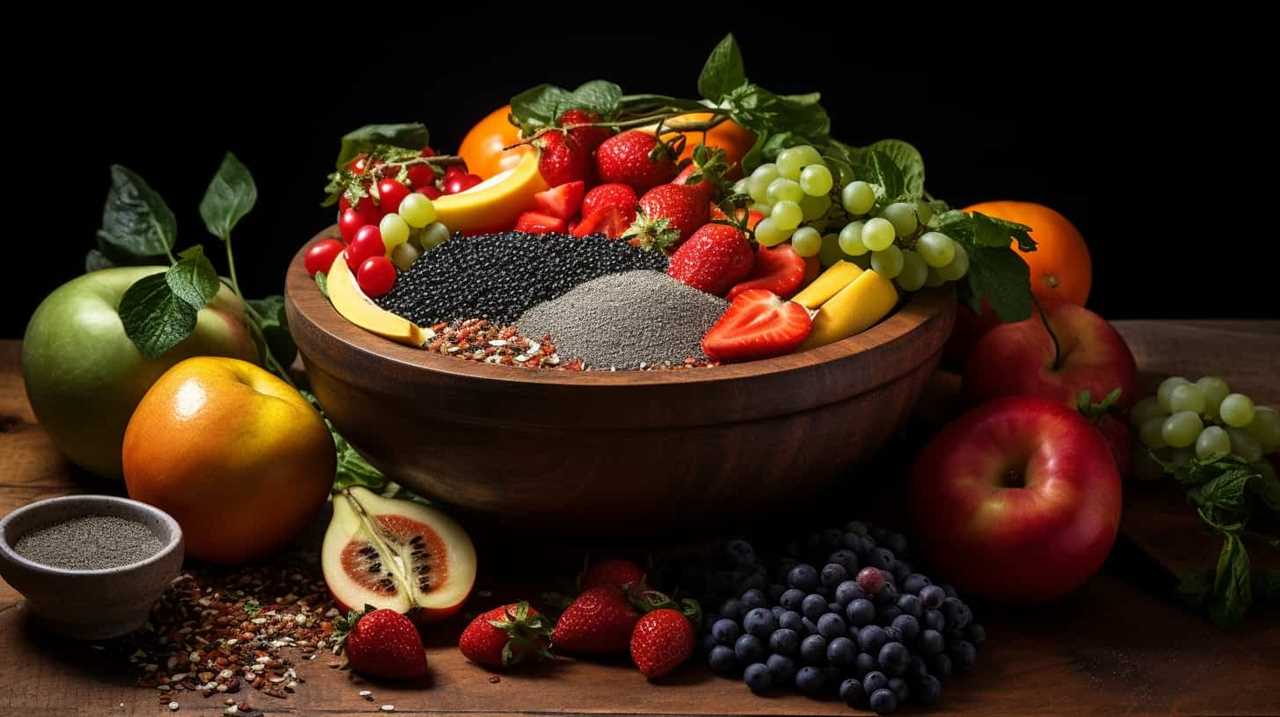
One such option is flax seeds, which offer a variety of health benefits. Flax seeds are rich in fiber, omega-3 fatty acids, and lignans, which are plant compounds with antioxidant properties. These seeds have been shown to reduce cholesterol levels, improve digestive health, and support heart health.
To incorporate flax seeds into our pancake recipe, we can simply substitute a portion of the chia seeds with ground flax seeds. This will add a nutty flavor and a slightly different texture to our pancakes, while still providing the same nutritional benefits.
Just like chia seeds, flax seeds are gluten-free and can be easily included in a gluten-free breakfast routine.
Chia Seed Granola Bars
Chia seeds are packed with health benefits, making them a great addition to granola bars. These bars can be customized with different variations, such as adding nuts, dried fruits, or chocolate chips.
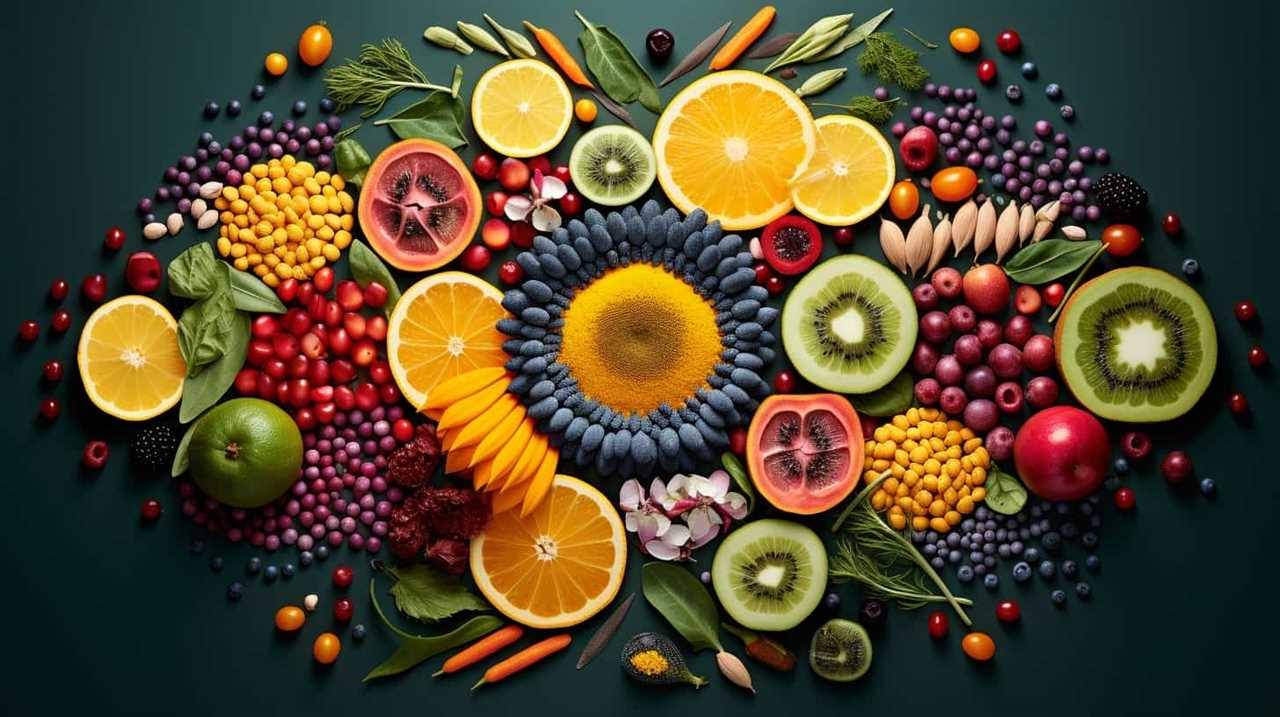
With easy chia seed recipes, you can enjoy a nutritious and delicious breakfast on the go.
Health Benefits of Chia Seeds
With the health benefits provided by chia seeds, we can create delicious and nutritious chia seed granola bars. Chia seeds are a powerhouse of nutrients that offer numerous health benefits.
Here are four reasons why incorporating chia seeds into your diet can be beneficial:
- Chia seeds for weight loss: Chia seeds are rich in fiber, which helps promote satiety and prevent overeating. They can help you feel fuller for longer, aiding in weight management.
- Chia seeds for digestion: These tiny seeds are packed with fiber and can help regulate bowel movements, promoting a healthy digestive system. They can also act as a prebiotic, nourishing the beneficial bacteria in your gut.
- Omega-3 fatty acids: Chia seeds are an excellent plant-based source of omega-3 fatty acids, which have anti-inflammatory properties and support heart health.
- Nutrient-dense: Chia seeds are loaded with essential vitamins, minerals, and antioxidants, including calcium, magnesium, and vitamin C.
Incorporating chia seeds into your diet, such as in chia seed granola bars, is a simple and delicious way to reap these health benefits.
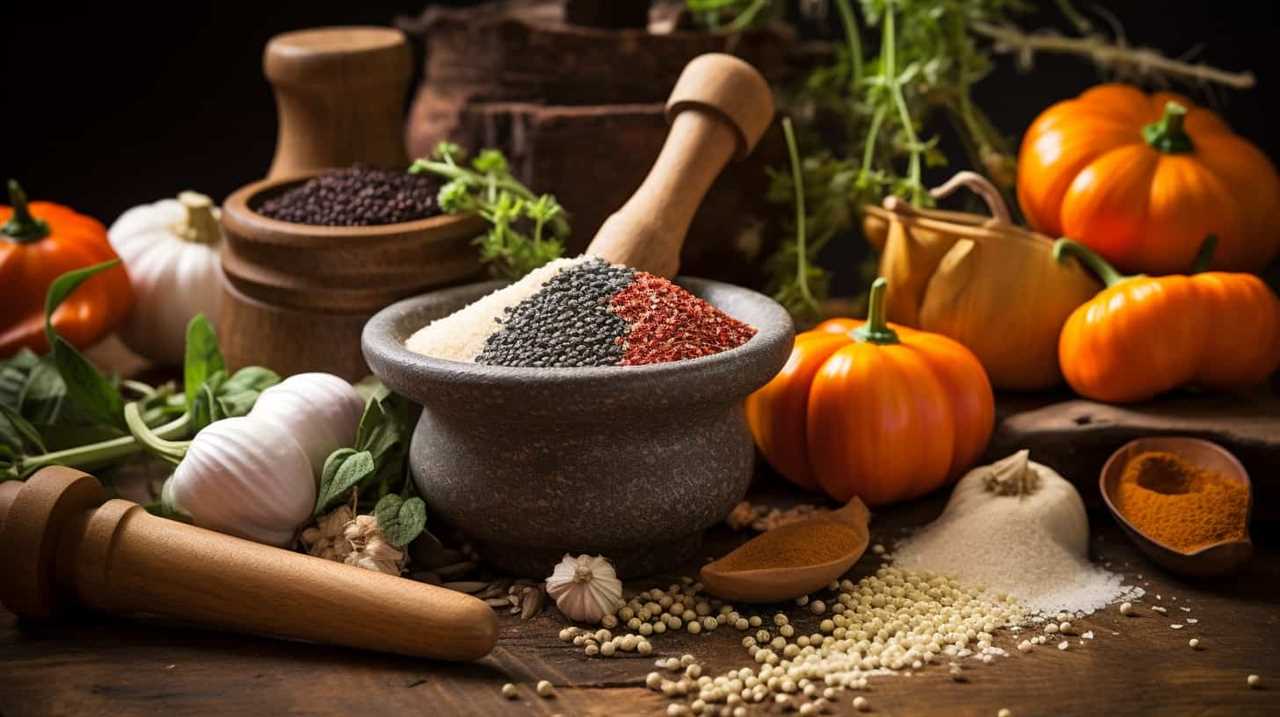
Variations of Granola Bars
As we continue exploring the health benefits of chia seeds, let’s now delve into the various delicious variations of granola bars that incorporate these nutritious seeds.
Chia seed energy bars are a fantastic way to start your day or provide a quick and healthy snack. They’re packed with fiber, protein, and omega-3 fatty acids, making them a nutritious choice for those looking to boost their energy levels and satisfy their hunger.
Homemade granola recipes allow you to customize your bars to your liking, adding in your favorite nuts, dried fruits, and sweeteners. By incorporating chia seeds into your granola bars, you aren’t only enhancing their nutritional value but also adding a delightful crunch and texture.
Easy Chia Seed Recipes
Let’s dive into some easy and delicious recipes for chia seed granola bars. Chia seeds aren’t only packed with nutrients, but they also add a delightful crunch to your breakfast. Here are four fantastic ways to incorporate chia seeds into your morning routine:

- Chia Seed Pudding Recipes: Start your day with a creamy and indulgent chia seed pudding. Simply mix chia seeds with your favorite milk and sweetener, then let it sit overnight. In the morning, top it with fresh fruits, nuts, or granola for added flavor and texture.
- Chia Seed Smoothie Recipes: Add a boost of nutrition to your smoothie by blending in chia seeds. They provide an extra dose of fiber and omega-3 fatty acids. Combine chia seeds with fruits, vegetables, and your choice of liquid for a refreshing and nutritious breakfast on the go.
- Chia Seed Granola Bars: Make your own homemade granola bars using chia seeds. Mix them with oats, nuts, dried fruits, and honey or maple syrup for a chewy and satisfying snack that will keep you energized throughout the morning.
- Chia Seed Banana Bread: Upgrade your traditional banana bread recipe by adding chia seeds. They not only enhance the nutritional profile but also give the bread a delightful texture. Enjoy a slice of chia seed banana bread with your morning coffee for a wholesome and delicious start to the day.
Now that we’ve explored these easy chia seed recipes, let’s move on to the next section where we’ll discover the wonders of chia seed banana bread.
Chia Seed Banana Bread
We love making chia seed banana bread for a gluten-free breakfast option packed with super seeds. Chia seeds are a great addition to any recipe because they’re rich in fiber, protein, and omega-3 fatty acids. They can help to keep you feeling full and satisfied throughout the morning.
Plus, chia seeds are incredibly versatile and can be used in a variety of ways. If you’re looking for other ways to incorporate chia seeds into your breakfast, you can try making chia seed muffins or chia seed porridge. Both of these options are delicious and easy to make.
Whether you choose chia seed banana bread or one of the other recipes, you can’t go wrong with the nutritional benefits of chia seeds.
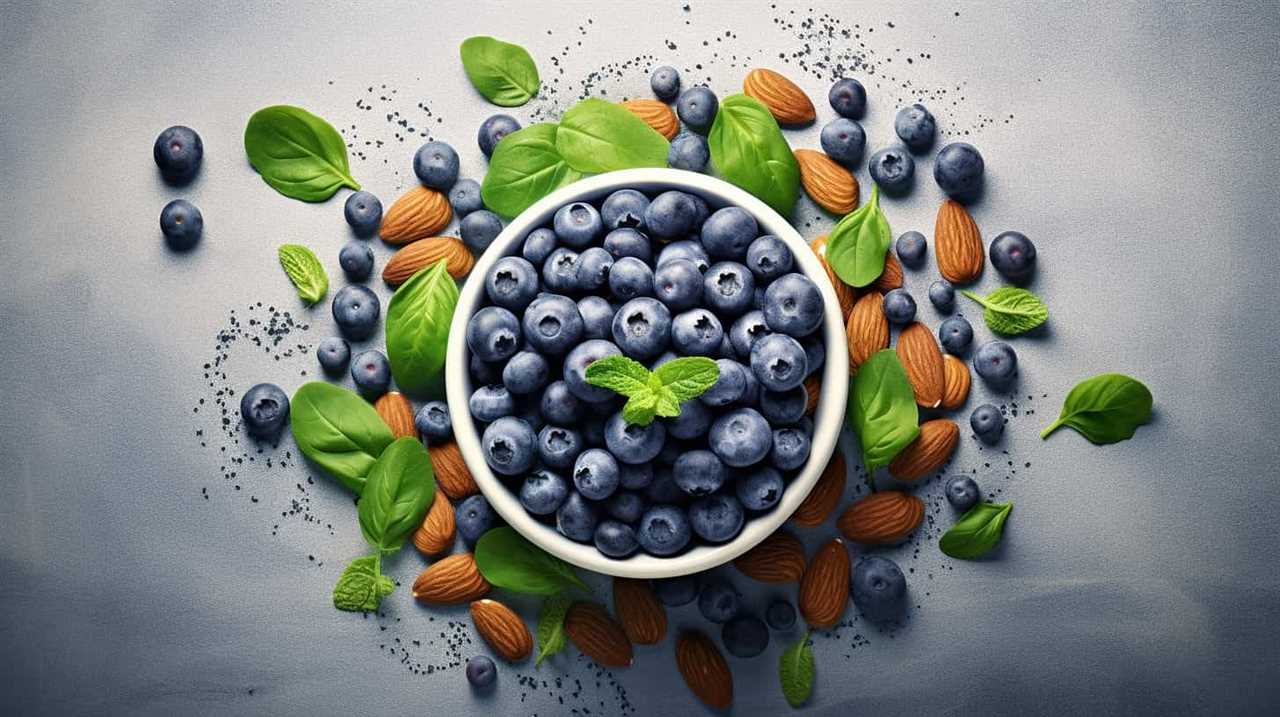
Chia Seed Energy Balls
To continue exploring the versatility of chia seeds in gluten-free breakfast options, let’s delve into the delicious world of chia seed energy balls. These little bites of goodness are packed with nutrients and make for a perfect on-the-go breakfast or snack. Here are four reasons why chia seed energy balls should be a part of your morning routine:
- Nutrient Powerhouse: Chia seeds are rich in omega-3 fatty acids, fiber, protein, and antioxidants. These energy balls provide a concentrated dose of these nutrients to fuel your day.
- Sustained Energy: The combination of chia seeds, nuts, and dried fruits in these energy balls gives you a steady release of energy, keeping you fueled and satisfied throughout the morning.
- Quick and Easy: With just a few simple ingredients and a food processor, you can whip up a batch of these energy balls in no time. They can be stored in the fridge for a grab-and-go breakfast option.
- Versatile and Customizable: You can customize your chia seed energy balls by adding different flavors like cocoa powder, peanut butter, or spices. You can also roll them in shredded coconut or crushed nuts for added texture.
Incorporating chia seed energy balls into your breakfast routine is a simple and delicious way to boost your energy levels and start your day off right. For even more chia goodness, pair these energy balls with a refreshing chia seed breakfast smoothie.
Chia Seed Breakfast Cookies
As we continue exploring gluten-free breakfast options with super seeds, it’s time to dive into the realm of chia seed breakfast cookies. Chia seeds are a powerhouse of nutrients and adding them to cookies not only enhances their nutritional value but also gives them a delightful texture. These cookies are perfect for those busy mornings when you need a quick grab-and-go breakfast. They are easy to make and can be customized with your favorite mix-ins like nuts, dried fruits, or chocolate chips. Here’s a simple recipe to get you started:
| Ingredients | Instructions |
|---|---|
| 1 cup gluten-free oats | 1. Preheat the oven to 350°F. |
| 1/2 cup almond flour | 2. In a mixing bowl, combine the oats, almond flour, chia seeds, baking powder, and salt. |
| 1/4 cup chia seeds | 3. In a separate bowl, whisk together the melted coconut oil, maple syrup, and vanilla extract. |
| 1 teaspoon baking powder | 4. Pour the wet ingredients into the dry ingredients and mix until well combined. |
| 1/4 teaspoon salt | 5. Fold in any additional mix-ins of your choice. |
| 1/4 cup melted coconut oil | 6. Drop spoonfuls of the dough onto a lined baking sheet and flatten them slightly. |
| 1/4 cup maple syrup | |
| 1 teaspoon vanilla extract |
Bake for 12-15 minutes or until golden brown around the edges. Allow the cookies to cool before enjoying them as a satisfying and nutritious breakfast treat. These chia seed breakfast cookies can be stored in an airtight container for up to a week, making them a convenient option for meal prepping. Experiment with different flavors and combinations to create your own delicious variations. For more chia seed breakfast ideas, you can also try chia seed breakfast muffins or chia seed smoothie recipes. Start your day off right with these gluten-free goodies packed with the power of chia seeds!
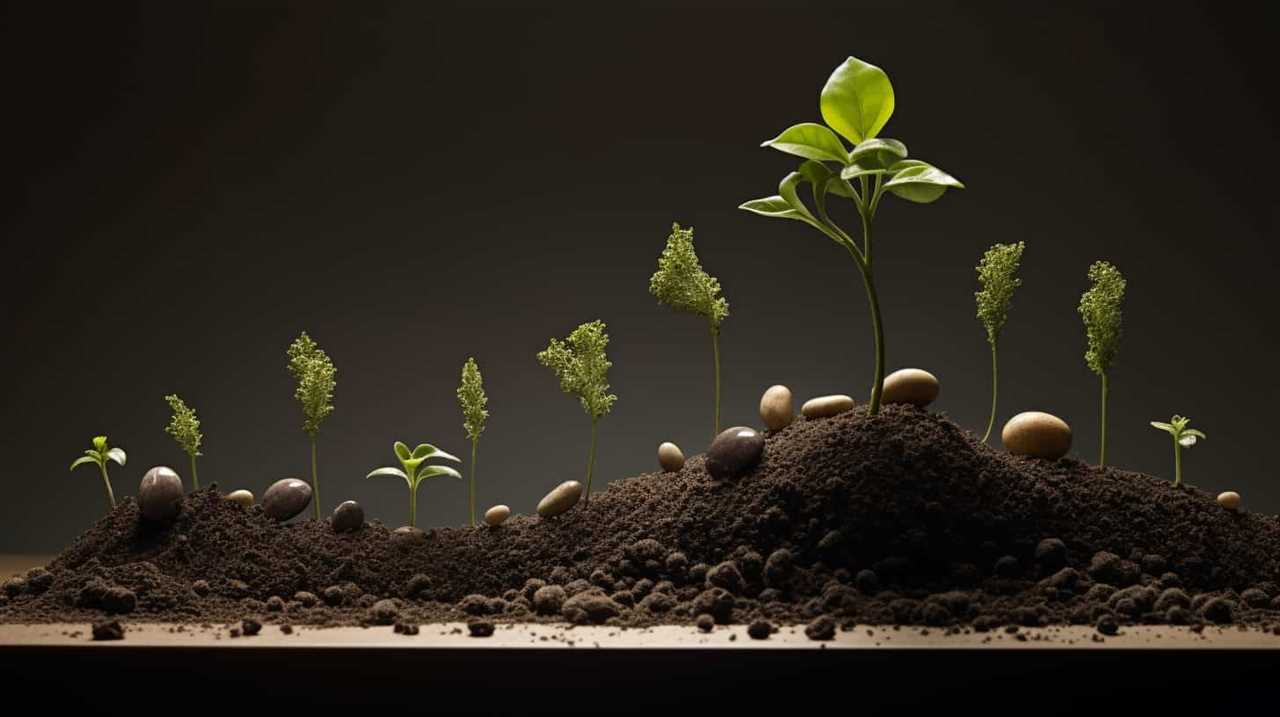
Chia Seed Yogurt Parfait
Continuing our exploration of gluten-free breakfast options with super seeds, let’s now delve into the irresistible realm of chia seed yogurt parfait. This delightful and nutritious breakfast dish combines the goodness of chia seeds with the creaminess of yogurt, resulting in a satisfying and energizing start to your day.
Here are four reasons why you should consider adding a chia seed yogurt parfait to your breakfast routine:
- Nutrient-packed: Chia seeds are rich in omega-3 fatty acids, fiber, and antioxidants, making them a powerhouse of nutrition.
- Digestive health: The high fiber content in chia seeds promotes healthy digestion and can help prevent constipation.
- Sustained energy: Chia seeds are known for their ability to provide long-lasting energy, keeping you satiated and focused throughout the morning.
- Customizable: You can personalize your chia seed yogurt parfait by adding fruits, nuts, or granola for added flavor and texture.
With its simplicity and versatility, the chia seed yogurt parfait is a fantastic addition to your gluten-free breakfast repertoire. So go ahead and give it a try, and enjoy a nutritious and delicious start to your day.
Frequently Asked Questions
How Many Grams of Chia Seeds Should I Consume in a Day?
We should consume around 15-30 grams of chia seeds per day for optimal health benefits. Incorporating chia seeds into meals and snacks is easy, like adding them to smoothies, yogurt, or baked goods.
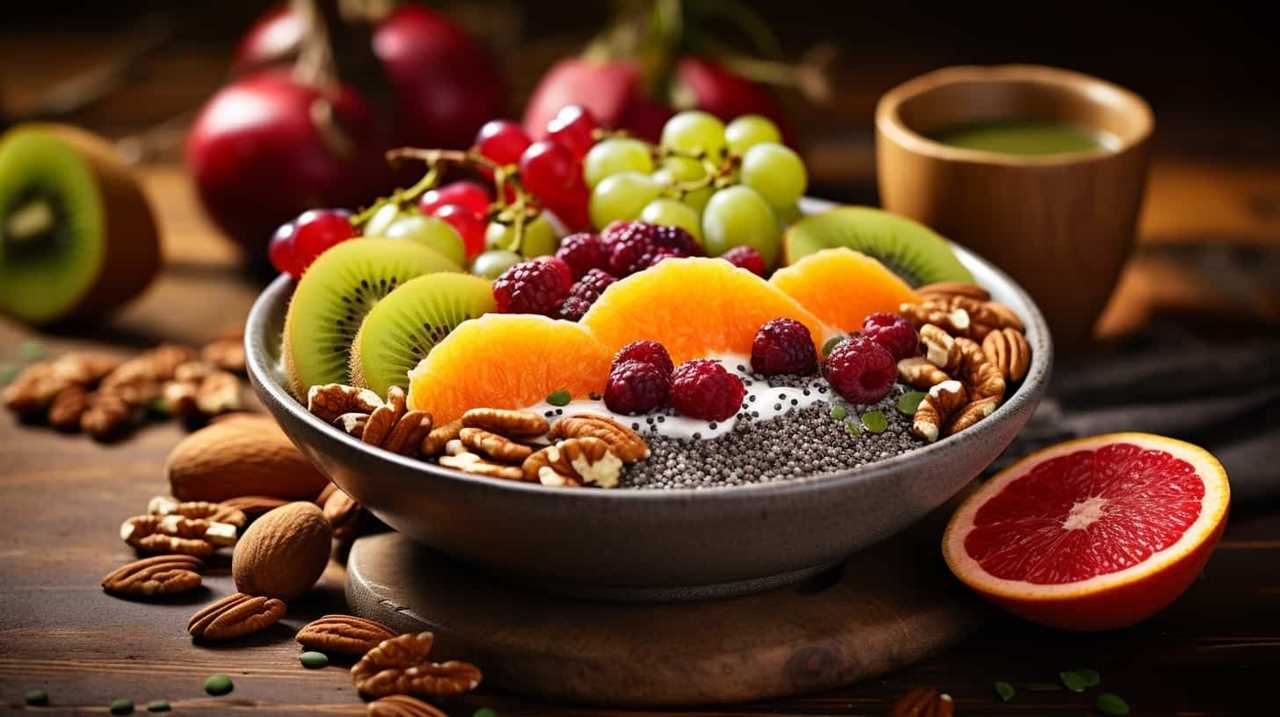
Can I Substitute Chia Seeds With Other Super Seeds in These Recipes?
Yes, you can substitute chia seeds with other super seeds in these gluten-free breakfast recipes. Incorporating super seeds like flaxseeds or hemp seeds into your diet can provide similar health benefits.
Are These Breakfast Recipes Suitable for People With Nut Allergies?
Yes, these breakfast recipes are suitable for people with nut allergies. There are alternative ingredients you can use, such as sunflower seeds or pumpkin seeds, to make them safe and delicious.
Can I Prepare These Recipes the Night Before and Refrigerate Them for a Quick Breakfast in the Morning?
Yes, we can definitely prepare these recipes the night before and refrigerate them for a quick breakfast in the morning. This helps save time and ensures maximum freshness when storing breakfast recipes.
Are There Any Variations or Additions I Can Make to These Recipes to Suit My Taste Preferences?
Variations and additions to suit taste preferences are abundant in these gluten-free breakfast recipes. From modifying the sweetener to adding different fruits or nuts, customization options ensure a breakfast that caters to your personal preference.

Conclusion
In conclusion, these gluten-free breakfast recipes with super seeds offer a delightful and nourishing way to start your day.
By incorporating chia seeds into your breakfast, you can enjoy a variety of delicious options that aren’t only tasty but also packed with nutrients.
These recipes provide evidence-based benefits for those with gluten sensitivities, making them a practical choice for a healthy and satisfying morning meal.
So go ahead and give these recipes a try to elevate your breakfast game and nourish your body.


